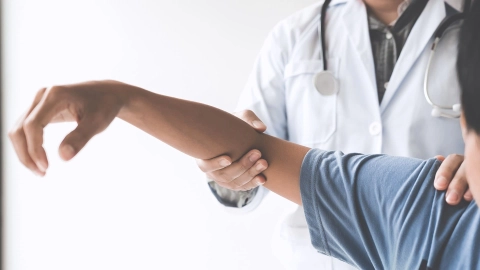Conditions Amyotrophic lateral sclerosis (ALS)
ICD codes: G12.2 What are ICD codes?
ALS is a serious condition affecting the motor nerve cells. These cells control the body’s muscles. With ALS, they increasingly lose function over time. This results in muscle loss and paralysis. At present, there is no cure for ALS. Treatment seeks to relieve symptoms as effectively as possible.
At a glance
- ALS is a progressive nervous system disease that causes motor neurons to die off. Motor neurons are nerve cells that control muscles.
- The exact cause of the disease remains unknown.
- ALS often begins with limited muscle weakness in the arms or legs or when speaking.
- More and more muscle groups are paralyzed as the disease progresses. Finally, the muscles used in breathing are affected.
- There is currently no cure for ALS but there are a number of treatment options.
- Treatment aims to slow the progression of the disease, relieve symptoms and maintain quality of life as far as possible.
Note: The information in this article cannot and should not replace a medical consultation and must not be used for self-diagnosis or treatment.

What is ALS?
ALS stands for amyotrophic lateral sclerosis, a progressive nerve disease affecting motor neurons. Motor neurons are special nerve cells that control muscles and movement.
The exact cause of ALS is unknown. Symptoms occur when motor neurons deteriorate and die off. Scarring (known as “sclerosis”) then occurs in the spinal cord and brain stem. The affected muscles also atrophy, i.e., waste away – in other words, they become amyotrophic.
The disease usually begins with muscle weakness limited to a specific location in the arms or legs. It sometimes becomes noticeable due to difficulties with swallowing or speaking. It also causes involuntary muscle twitches and muscle stiffness.
Paralysis spreads as the disease progresses, and may eventually also affect the respiratory muscles used for breathing.
The average life expectancy for people with ALS is 3 to 5 years following diagnosis. Some people live for longer than 10 years.
There is currently no treatment that can cure ALS. The treatments that are available seek to maintain quality of life as far as possible.
What are the symptoms of ALS?
ALS becomes noticeable when the first nerves controlling movement are destroyed.
A wide range of symptoms may initially occur because these nerves may be located in various parts of the brain and spinal cord (central nervous system).
Possible symptoms of ALS include:
- muscle weakness that increases over weeks or months – this may be indicated by restricted movement or clumsiness
- muscle loss (atrophy)
- muscle spasms, muscle twitches, muscle stiffness (spasticity)
- problems with speaking (dysarthria) or swallowing (dysphagia)
- increased salivary flow
- breathing problems, shortness of breath
- sleepiness, fatigue
- uncontrolled laughing or crying
- behavioral changes
- cognitive impairment or even dementia
As a rule, symptoms become progressively and continuously worse. For example, if only one arm is affected, the disease will spread to the opposite arm over time, and then to the legs.
Finally, muscle paralysis occurs in the muscles used for breathing and this may be life-threatening.
What causes ALS?
ALS causes degeneration of motor neurons in the brain stem and spinal cord. Motor neurons are special nerve cells that control muscles. However, it may also destroy nerve cells that are responsible for thinking or memory, for example.
The trigger for this destruction of nerves is unknown. It appears that various mechanisms in the cells may be responsible.
Around 10 percent of ALS cases are inherited and occur due to changes in genetic material. There are various genes that are potentially responsible for triggering ALS.
It is also possible that environmental factors play a role.
Which factors increase the risk of developing ALS?
The only risk factors that are proven to have a connection with ALS are increasing age and the occurrence of ALS within the family.
While it has often been hypothesized that ALS is connected with certain toxic substances in the environment, this has yet to be proven.
How common is ALS?
ALS is a rare condition. Every year, around 1 to 3 people in every 100,000 are diagnosed with it.
Its prevalence increases among those aged over 40. Most people diagnosed with ALS are between 60 and 75 years old.
Men are affected slightly more often than women by ALS.
What is the outlook for ALS?
ALS causes a continuous, progressive degeneration in muscle function. It often affects only one arm or leg, before eventually spreading to all four limbs. As it is impossible to predict how quickly the disease will progress, people with ALS should be given as much support as possible to help them continue to participate in daily life.
Many symptoms can be treated using technical aids or medication. The condition becomes acutely life-threatening when the respiratory muscles (used in breathing) are affected.
People with ALS should speak with their loved ones as soon as possible about whether they want to be artificially ventilated if the worst happens.
Important: An advance healthcare directive, also known as a living will, allows people to specify which medical measures they wish to be taken on their behalf and which they do not.
How is ALS diagnosed?
There are many diseases with symptoms similar to those of ALS. There is currently no test that can reliably detect or exclude ALS. Therefore, several criteria need to be met and other diseases ruled out before a diagnosis of ALS can be made.
Diagnosis is based in particular on disease symptoms detected in a physical examination.
The symptoms differ depending on whether the upper or lower motor neurons (i.e., nerves controlling movement) are destroyed. Loss of upper motor neuron function (in the brain) leads to muscle loss, while loss of lower motor neuron function (in the spinal cord) causes increased muscle stiffness.
ALS is diagnosed if:
- both upper and lower motor neurons are damaged
- the symptoms occur in more than one region of the body and spread
- there is no other explanation for the symptoms
Doctors perform various tests to enable a precise diagnosis. For example, they test how well the reflexes are working and how strong the muscles are. They also use methods such as electroneurography (ENoG) and electromyography (EMG) to test how well the nerve pathways are functioning and conducting nerve impulses.
Magnetic resonance imaging (MRI) is primarily used to rule out other causes of the symptoms. However, it can sometimes also provide indications of ALS.
Genetic testing may also be considered under certain circumstances.
How is ALS treated?
To date, no treatment to cure ALS has been found. ALS treatments therefore seek to relieve the symptoms.
The person’s quality of life and their ability to cope with everyday life need to be reviewed on an ongoing basis so that care aids and support can be provided as soon as they are needed.
The therapeutic team involves experts from neurology, physiotherapy, occupational therapy, speech and language therapy, nursing, nutrition and social counseling.
Drugs containing the active ingredient riluzole or edavarone may slow the progression of the disease.
With increasing paralysis, it is important to maintain good movement in the limbs with the assistance of physiotherapy.
Quality of life improves if social contact is maintained.
Medication, medical devices and technical care aids are used for treatment.
Treatment is adjusted depending on which symptoms occur:
- If the person suffers a weakening of respiratory function and finds it difficult to loosen mucus in the chest, there are various exercises and breathing therapy devices that support breathing and help loosen mucus.
- Increased salivary flow (drooling) can be reduced by taking various types of medication in tablet form or as an injection.
- Swallowing difficulties and weight loss can initially be treated by changing the composition and consistency of the food in the person’s diet. Artificial feeding via stomach tube is also possible.
- If speech is impaired, various technical aids can help the person to continue to communicate.
- Medication and physiotherapy help with muscle spasms and pain.
- Increasing paralysis often means that people with ALS ultimately need to use a wheelchair.
- Psychological symptoms such as anxiety and depression or sleep disturbances can be relieved with medication.
There are also many experimental therapies that people can try by taking part in clinical trials. The purpose of these is to test new medications and forms of therapy. You will find an overview of current trials on the website of the outpatient clinic for ALS and other motor neuron diseases at the Charité University Hospital in Berlin.
Where can I find support for advanced ALS?
Patients require more intensive care as their ALS progresses. If the level of care cannot be managed at home, care in a hospice becomes an option. Hospices have all of the resources needed to provide intensive end-of-life care for ALS patients and to give them the dignity they deserve.
People with ALS should not be afraid to discuss at an early stage how they want to be cared for at the end of their life.
Important: A lasting power of attorney (LPA) or guardianship directive can be used to determine who is to be responsible for care of the patient and for making decisions on the patient’s behalf if the worst happens.
Where can I find more information about ALS?
An ALS diagnosis is life-changing for the person with the condition and for their loved ones. It is important to know what to expect and how to cope best with the challenges ahead.
For more information about diagnosing and treating ALS and about the latest research, visit the website of the outpatient clinic for amyotrophic lateral sclerosis (ALS) and other motor neuron diseases at the Charité University Hospital in Berlin.
For more detailed information about ALS, including how to cope with getting a diagnosis and meeting the challenges associated with the condition, see the websites of the German Society for Muscle Diseases (Deutsche Gesellschaft für Muskelkranke e.V.) and the German Brain Foundation (Deutsche Hirnstiftung e.V.).
- Brotman RG, Moreno-Escobar MC, Joseph J, Pawar G. Amyotrophic Lateral Sclerosis. [Updated 2022 May 09]. In: StatPearls (Internet). Treasure Island (FL): StatPearls Publishing. 2022 Jan-. Aufgerufen am 31.10.2022.
- DynaMed [Internet]. Ipswich (MA): EBSCO Information Services. Amyotrophic Lateral Sclerosis (ALS). Aufgerufen am 31.10.2022.
- UpToDate (Internet). Clinical features of amyotrophic lateral sclerosis and other forms of motor neuron disease. Wolters Kluwer 2022. Aufgerufen am 31.10.2022.
- UpToDate (Internet). Diagnosis of amyotrophic lateral sclerosis and other forms of motor neuron disease. Wolters Kluwer 2022. Aufgerufen am 31.10.2022.
- UpToDate (Internet). Disease-modifying treatment of amytrophic lateral sclerosis. Wolters Kluwer 2022. Aufgerufen am 31.10.2022.
- UpToDate (Internet). Epidemiology and pathogenesis of amyotrophic lateral sclerosis. Wolters Kluwer 2022. Aufgerufen am 231.10.2022.
Reviewed by the German Neurological Society (Deutsche Gesellschaft für Neurologie e.V. – DGN).
As at:





